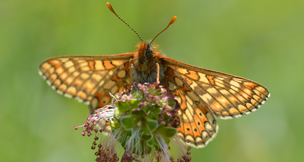Cattle are set to return to a South Wales common following recent work which is set to help butterflies and wildlife in the area.
Funding from Natural Resources Wales has enabled Neath Port Talbot Council’s Countryside & Wildlife Team to work alongside Butterfly Conservation (BC) and install new cattle grids on either side of Crynant's Rhos Common.
Opening the land up for Commoners to graze cattle during the summer months will mean that it can be better managed to both benefit local wildlife and reduce hazards such as grass fires and flooding.
The area has previously been vulnerable to arson attacks, with deliberate grass fires causing problems annually for local residents and agencies. Allowing cattle to graze the land will reduce the potential fire load and also improve the ability of the common to hold water, helping to alleviate flooding during periods of wet weather.
Grazing will also help to better maintain the Purple Moor Grass and rush pasture habitat of the common, a type of habitat recognised as being of Europe-wide significance due to its decline in many areas. This in turn will benefit the rare Marsh Fritillary Butterfly, a threatened European species that is declining rapidly in the UK but one that has a stronghold in the Ystradgynlais area.
The cattle grids will allow the Commons Association to fulfil the requirements of the Welsh Government ‘Glastir’ scheme. The initiative is designed to encourage farmers to manage their land in a way that reduces the impact on climate change and the environment.
Leader of Neath Port Talbot Council Cllr Ali Thomas said: “This fantastic project will allow this landscape to be managed in a traditional and cost-effective way, providing benefits to the Dulais Valley and surrounding area. By helping the Commoners to observe their grazing rights, we will make a real difference to the local habitat and the internationally important species which it supports.
“The work will also help to reduce the burden of such issues as deliberate grass fires and flooding which are regularly faced by the Council and its partners”.
Russel Hobson, Head of Conservation for BC Wales said ‘Rhos Common is a critical part of a wider network of wet grasslands that support the Marsh Fritillary crossing the borders of Neath Port Talbot, Powys and the National Park."


